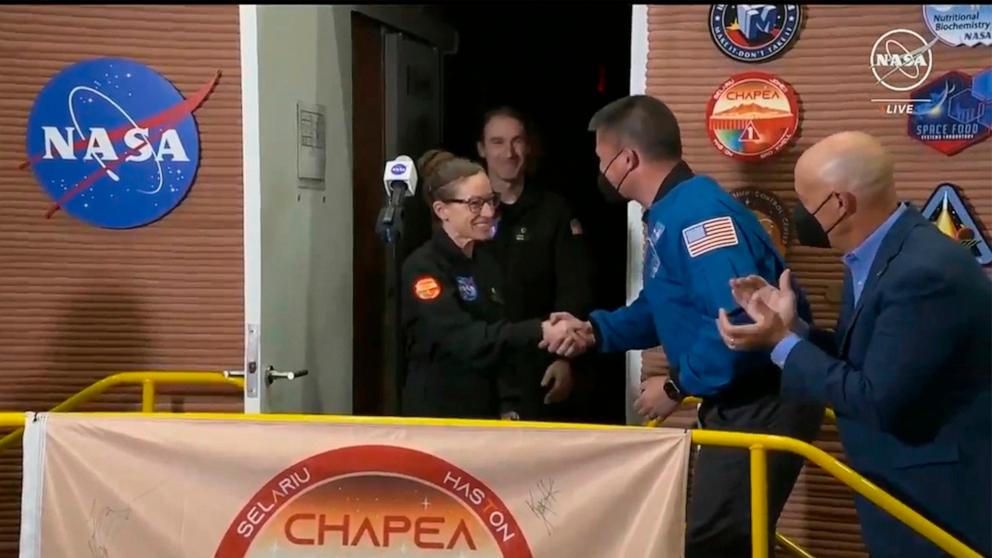For more than a year, four crew members of NASA’s Mars Dune Alpha communicated, ate, slept and acted out a simulated experience as if they were stationed more than 200 million miles away on the Red Planet.
The mission, which marked the first completed portion of three planned programs of NASA’s Crew Health and Performance Exploration Analog (CHAPEA), lasted 378 days and launched on June 25, 2023.
Kelly Haston, Anca Selariu, Ross Brockwell and Nathan Jones were greeted with applause last weekend as they emerged from their 1,700-square-foot, 3D-printed habitat at the Johnson Space Center in Houston, Texas.
“Hello. It’s just so great to be able to greet you all,” CHAPEA Commander Haston said during a press conference as she emerged from the habitat.
The program was designed to study how crew members would respond to the conditions and constraints of a year-long mission. NASA says they could send astronauts to Mars as early as the 2030s.
“Mars is our goal,” Stephen Koerner, deputy director of NASA’s Johnson Space Center, said during Saturday’s news conference. “As global interests and capabilities in space exploration continue to grow, America stands ready to lead the way,” he said, adding: “The completion of the CHAPEA-1 mission is a significant step toward that goal.”
Simulated spacewalks, robotic operations, habitat maintenance, exercises and crop growing were among the crew’s daily activities during the mission.
According to NASA, the CHAPEA crew simulated a realistic communications delay of up to 22 minutes one-way, which is similar to the delay at Mars. This included messages with mission control and communications with the crew’s friends and family outside the mission.
No fresh food was provided, so team members had to rely on pre-packaged, non-perishable foods and were allowed to grow some crops during the mission.
According to NASA, the crop growth system in the CHAPEA habitat is similar to systems used for indoor gardening and can support the growth of leafy vegetables, herbs, and small fruits.
“I am grateful for the opportunity to live with the idea that we should not use resources faster than they can be replenished, and we should not produce waste faster than we can turn it back into resources,” crew member Brockwell said during the press conference.
Mars Dune Alpha offered four separate sleeping quarters for crew members, totaling 1,700 square feet, NASA said. The habitat included a bathroom and shower, a kitchen and living area with a table and furniture, and designated areas for exercise and laundry.
Suzanne Bell, director of NASA’s Behavioral Health and Performance Laboratory at the Johnson Space Center, spoke to ABC News in February as the agency was looking for new staff for the second mission.
“We’re replicating what we expect from a Mars habitat surface mission,” Bell said. “We’re collecting all kinds of data so we can learn how humans can survive and thrive in those conditions.”
The next CHAPEA mission is planned for spring 2025, with the third mission expected to launch in 2026.
Bell said the three missions are designed to eliminate the “difference of any particular crew or individuals.”
“We are seeing how we can best support people in the circumstances for their human health. We are starting to see trends that we can interpret to best support people of the future,” Bell explained.
To be eligible for the program, volunteers must be healthy, non-smoking U.S. citizens or permanent residents between the ages of 30 and 55 and fluent in English.
Crew members must have a master’s degree with STEM qualifications and experience in the field, or a minimum of 1,000 hours of experience as an aircraft pilot, or the required military experience.
“I’ve often been asked: Why the obsession with Mars? Why go to Mars?” crew member Selariu said after the mission. “Because it’s possible,” Selariu continued, adding: “Because space can unite us and bring out the best in us. Because it’s a defining step that Earthlings will take to light the way for the next centuries.”
